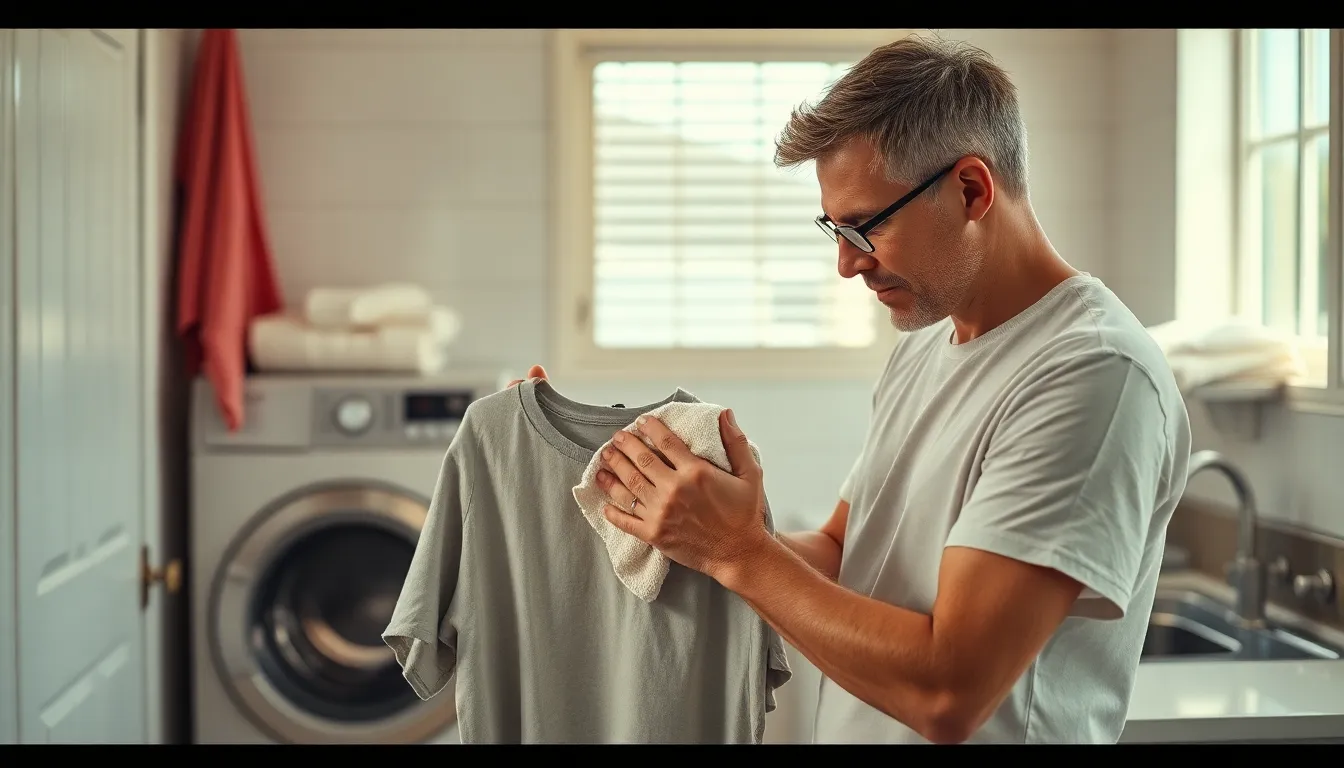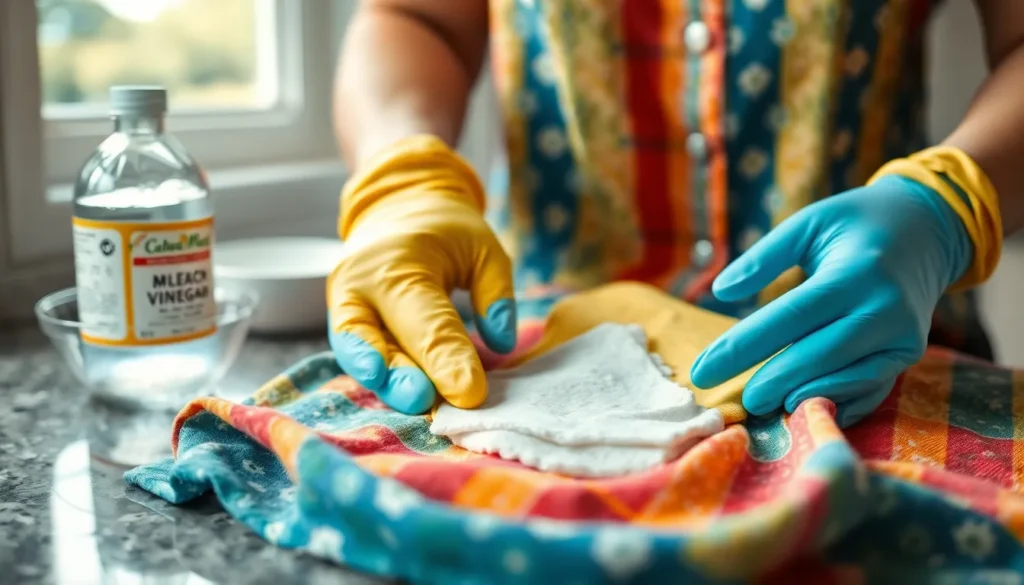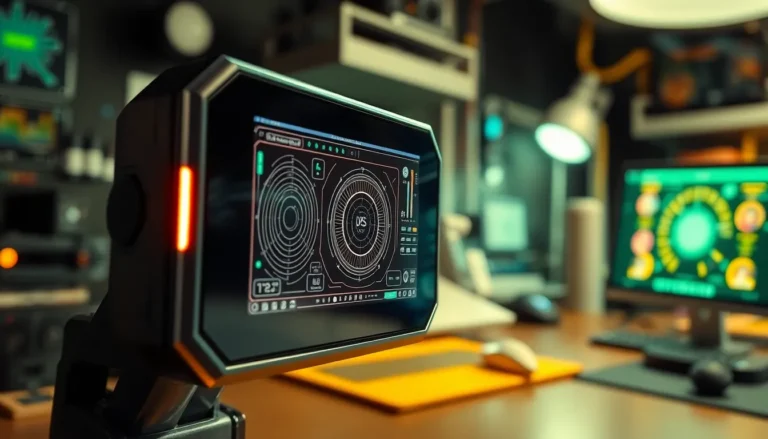Table of Contents
ToggleAccidents happen, and sometimes that innocent bottle of bleach turns into a fashion disaster. One moment you’re sprucing up your whites, and the next, you’ve got a tie-dye masterpiece that would make even the most avant-garde artist cringe. Don’t panic just yet! Before you toss that shirt into the “doomed to the rag pile” bin, there’s hope.
Understanding Bleach Stains
Accidental bleach spills can lead to frustrating situations, but recognizing the type of bleach stain and understanding the chemistry behind it can help salvage clothing.
Types of Bleach Stains
Two primary types of bleach stains often occur on fabrics: direct stains and faded areas. Direct stains result from a concentrated bleach spill, leaving sharp, defined marks. Faded areas happen when bleach gradually lightens fabric over time, creating subtle discoloration. Different fabrics react uniquely to bleach, affecting the stain’s appearance. Cotton may show more noticeable white spots, while synthetic fibers can appear faded but less discolored. Identifying the specific type of stain is crucial for determining the best approach to treatment.
The Chemistry of Bleach on Fabric
Bleach contains sodium hypochlorite, a powerful agent that disrupts color molecules in fabrics. When bleach contacts dye, it breaks chemical bonds, leading to discoloration. Factors such as fabric composition, dye type, and bleach concentration influence the stain’s severity. Natural fibers like cotton and wool absorb bleach more readily than synthetic ones. Understanding these elements helps in forming a strategy to address the stain. Applying a neutralizing agent or color repair treatment can potentially restore some of the original appearance of the garment.
Immediate Steps to Take

Act quickly when bleach spills on clothing to increase the chances of removal. Follow these steps for the best results.
Blotting the Stain
Blot the affected area immediately using a clean cloth or paper towel. Avoid rubbing; doing so can spread the bleach further into the fabric. Use a separate section of the cloth for each blot to prevent further damage. A gentle pat helps absorb the bleach without pushing it deeper into the fibers. After blotting, assess the stain and determine if additional steps are necessary based on the fabric type and stain severity.
Rinsing with Cold Water
Rinse the stained area thoroughly with cold water. Directly placing the garment under running water helps dilute the bleach. Allow the fabric to soak for several minutes, ensuring that water reaches all affected areas. After rinsing, gently squeeze out excess water without wringing. Continue to rinse until the water runs clear and no bleach residue remains. This step significantly reduces the risk of further discoloration.
Home Remedies for Removal
Several effective home remedies exist for removing bleach stains from clothes. Each remedy targets specific types of stains and fabric reactions.
White Vinegar Solution
White vinegar serves as a natural remedy for bleach stains. This acidic solution neutralizes bleach, stopping further damage to fabric. To use, mix one part white vinegar with two parts water in a bowl. Dampen a clean cloth with the solution, then blot the stained area gently. It’s important to avoid rubbing; instead, let the mixture sit for about five minutes. Rinse the area with cold water afterward to ensure all vinegar and bleach residues are removed. This method works best on cotton and synthetic fabrics.
Baking Soda Paste
Baking soda offers a gentle yet effective option for treating bleach stains. This remedy helps absorb bleach and aid in reducing visible discoloration. To create a paste, combine three tablespoons of baking soda with one tablespoon of water. Apply the paste directly onto the stain and let it sit for about 30 minutes. Gently scrub with a soft-bristled toothbrush after the time is up, then rinse thoroughly with cold water. This method is particularly useful for preserving the integrity of colors in mixed fabric blends.
Commercial Products for Stain Removal
Commercial products can effectively address bleach stains on clothing. Various stain removers target different fabric types and promote optimal results.
Recommended Stain Removers
OxiClean MaxForce works well for many stubborn stains, including those caused by bleach. This versatile product contains several cleaning agents designed for multiple fabrics. Clorox 2 Stain Remover & Color Booster helps restore color while removing bleach stains effectively. This option contains color-safe ingredients suitable for dark or colored fabrics. Another choice, Zout Laundry Stain Remover, effectively tackles bleach and other common stains by combining enzymes that break down discoloration.
How to Use Them Effectively
Following the instructions on product labels ensures proper application. Apply the stain remover directly to the affected area, ensuring the fabric is damp. Let the product sit for the recommended duration—usually around 5 to 10 minutes. After this, rinse the area thoroughly with cold water to remove any residual chemicals. Laundering as usual afterward can further enhance stain removal results. Testing the product on a hidden fabric area first is always advisable to prevent unwanted damage.
Prevention Tips for Future Incidents
Accidental spills happen frequently, but certain measures can minimize the risk of bleach mishaps. Proper handling and safe storage are crucial elements.
Proper Handling of Bleach
When using bleach, always work in a well-ventilated area. Ensure that you wear protective gloves to shield your skin from irritation. Avoid pouring bleach directly from the container; instead, use a measuring cup or spray bottle to control the amount applied. While handling bleach, keep it away from clothing and fabrics to prevent accidental spills. Immediately clean any spills with paper towels, and wash your hands thoroughly after use. By practicing these steps, individuals can significantly reduce the chances of bleach staining clothes.
Safe Storage Practices
Store bleach in a designated area, ideally away from other cleaning products. Use a high shelf or a locked cabinet to prevent accidental access, especially in homes with children or pets. Ensure that the bleach container remains tightly closed when not in use. Label the container clearly to identify its contents easily. Consider using opaque containers to minimize light exposure, which can degrade bleach over time. By implementing these storage practices, individuals can help prevent unwanted bleach exposure and maintain safer environments.
Accidentally spilling bleach on clothing can be frustrating but it doesn’t have to spell the end for a favorite garment. With the right knowledge and techniques, it’s possible to treat and even restore affected fabrics. By understanding the type of bleach stain and acting quickly, individuals can employ effective home remedies or commercial products to improve the situation.
Preventative measures are essential for avoiding future mishaps. By handling bleach carefully and storing it properly, the risk of stains can be significantly reduced. With a little effort and the right approach, anyone can keep their wardrobe looking its best despite the occasional bleach accident.



